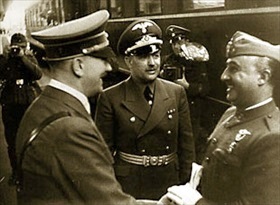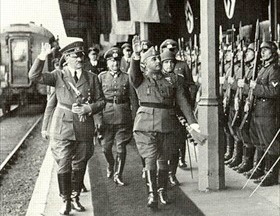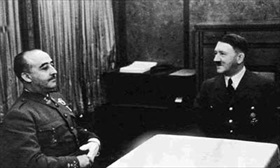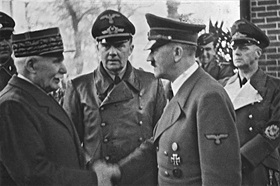HITLER-FRANCO MILITARY PACT POSSIBLE
Hendaye, France · October 23, 1940
In late November 1939, shortly after the start of World War II, the nominally neutral but fascist government of Generalissimo Francisco Franco ratified a pact with Germany in which Spain promised “more than favorable” neutrality. On this date in 1940 in Hendaye, a town on the Franco-Spanish border, Adolf Hitler pressed the Spanish leader to join the Axis camp, consisting then of Germany and Italy. Hitler’s meeting with Franco and the next day with Vichy France head Marshal Philippe Pétain was to solidly secure the western part of Europe for the Axis before embarking on his crusade against the Soviet Union (Operation Barbarossa) in mid-1941. In return, Hitler offered to assist Spanish forces in driving the British out of their Gibraltar fortress on the southern tip of the Iberian Peninsula (entrance to the Mediterranean), even setting a date for the deed: January 10, 1941. The implication was that Spain would then partner with Germany and Italy in their war against Great Britain. The wily Franco rejected direct German assistance in seizing the British stronghold. Spanish pride required that Spanish troops carry out the historic mission, he told Hitler. What he wanted as compensation for Spain entering the war on the side of the Axis was equipment, money, and foodstuffs to alleviate the effects of the Spanish Civil War (1936–1939). To top it off, he demanded border changes with France and practically all the French colonies in North Africa, including Algeria and Morocco. Acceding to Franco’s demands would have harmed Germany’s relations with Vichy France, which had concluded an armistice with Germany four months earlier. German foreign minister Joachim von Ribbentrop called Franco a “cowardly ingrate” in light of Axis assistance to Franco in the civil war. In a letter to Franco, dated February 6, 1941, Hitler wrote that Italian dictator Benito Mussolini, Franco, and he himself were linked to one another by the most implacable force of history. Hitler’s flattery failed to nudge Franco, who nonetheless assured Hitler of his loyalty and stressed his solidarity with the Axis short of military engagement. To Mussolini, Hitler predicted that Franco’s rebuff would be the biggest mistake in the Spaniard’s life. Actually, it wasn’t. Of all the European dictators who sided with Hitler and Mussolini, Franco was the only one not to share their fate—dying peacefully in his bed in 1975 after almost four decades in power.
[amazon_carousel widget_type=”ASINList” width=”600″ height=”200″ title=”Recommended Reading” market_place=”US” shuffle_products=”False” show_border=”False” asin=”0300151225,0299302105,1574886452,1929631421,0393049949,0316023744,1480264393,1904950329,1405824697,0582437539″ /]
Adolf Hitler on His Quest to Add Spain and Vichy France to the Axis
 |  |
Left: On October 23, 1940, Hitler’s special train rolled into Hendaye, a French town that borders Spain in the Pyrenees. There he was warmly greeted by a suspicious Francisco Franco (1892–1975), who ruled over Spain from 1939 until his death on November 20, 1975. According to Franco’s daughter, her father was worried about the Germans possibly kidnapping him and forcing him to take Spain into the war on the Axis side.
![]()
Right: Franco had arranged an extremely festive reception and honor guard for his meeting with Hitler. Hitler immediately got down to business. He explained that he looking for allies in his war against Great Britain. Naturally there must be a quid pro quo, said Franco, who needed money to rebuild roads and railway lines destroyed during the Spanish Civil War, foodstuffs, and military equipment to rebuild his army among other needs. Plus, he was interested in acquiring important French holdings in North Africa to add to his own modest holdings there.
 |  |
Left: There was no meeting of the minds inside Hitler’s Sonderzug (private railway car) where the two leaders spent seven-plus hours in fruitless discussions. Hitler told Franco that his trip had been useless in light of Franco’s reluctance to enter the war on the Axis side. Though Franco claimed his country was a neutral state, in August 1941 he sent some 45,000 volunteers (the “Blue Division,” or División Azul) to fight alongside the Germans on the Soviet front. Franco also opened his ports to German submarines and invaded the internationally administered city of Tangier in Morocco after the fall of France in 1940.
![]()
Right: Upset with the results of his meeting with Franco (Hitler fumed to Field Marshal Wilhelm Keitel: “I’d rather have three of my teeth pulled than have another meeting like this one”), Hitler hoped to fare better with the 84‑year-old Vichy Head of State Marshal Philippe Pétain when the two met in Montoire, France, on October 24, 1940. A polite duel ensured between Hitler and Pétain, who wanted to know what fruits France would harvest by collaborating with Germany: Germany still held more than two million French POWs and there was the issue of France incurring huge costs in maintaining the German occupation army on French soil, etc., etc. Hitler managed, however, to persuade the French Marshal to put in writing France’s support, “within the limits of its ability,” for measures the Axis powers took to defeat and occupy England.
Hitler and Gen. Francisco Franco Confer in Hendaye, France, October 23, 1940 (in Spanish)
![]()

 History buffs, there is good news! The Daily Chronicles of World War II is now available as an ebook for $4.99 on Amazon.com. Containing a year’s worth of dated entries from this website, the ebook brings the story of this tumultuous era to life in a compelling, authoritative, and succinct manner. Featuring inventive navigation aids, the ebook enables readers to instantly move forward or backward by month and date to different dated entries. Simple and elegant! Click
History buffs, there is good news! The Daily Chronicles of World War II is now available as an ebook for $4.99 on Amazon.com. Containing a year’s worth of dated entries from this website, the ebook brings the story of this tumultuous era to life in a compelling, authoritative, and succinct manner. Featuring inventive navigation aids, the ebook enables readers to instantly move forward or backward by month and date to different dated entries. Simple and elegant! Click 











